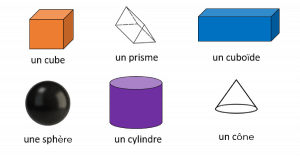Math in French: Master the basics in Kindergarten and First Grade
Why not try a bit of math in French next time you get the chance to visit France? Although it might be tempting to stop working altogether, there are plenty of things you can do when on vacation to keep the wheels turning.
To help, it might be a good idea to think of math in a foreign language. This will help your child to continue their development and have fun while away from school this summer. And, before you know it, they will be conversing with others using their newfound knowledge!
2D Shapes Math Posters Kindergarten – Grade 1
Printable math posters designed to display key information on 2D Shapes for Kindergarten and Grade 1. Great to use as part of an engaging classroom display!
Download Free Now!So, without further ado, let’s get started with some math home learning – in French!
For anyone who is wondering, the French word for math is mathématiques.
Now that we’ve got that out of the way… let’s take a look at some basic vocabulary together to get you started:
Numbers
Numbers are a good place to start. Mastering these will help your child to start using French when you are out and about.

Consistently reading these out loud and reciting them together will push these terms into your long-term memory.
You might then want to use these numbers in a holiday-themed sentence. Perhaps:
Je voudrais + [number] + glaces = I would like + [number] + ice creams
For example:
Je voudrais deux glaces = I would like two ice creams

Meet Skye, the voice-based AI tutor making math success possible for every student.
Built by teachers and math experts, Skye uses the same pedagogy, curriculum and lesson structure as our traditional tutoring.
But, with more flexibility and a low cost, schools can scale online math tutoring to support every student who needs it.
Find out moreFour Operations
Do we all remember our operations?
In math, operations refer to addition, subtraction, multiplication and division.
Fortunately, most of the four operations are the same as their English equivalents so it might not take long for your child to remember these!
- addition = l’addition
- subtraction = la soustraction
- multiplication = la multiplication
- division = la division
2D Shapes
Once your child has mastered the french numbers and operations, you can then move them on to talking about shapes.
Why not try finding one of the shapes below when you’re on vacation? Perhaps a nice square piece of cake?
This will really start to get their brain working:

Try to encourage your child to incorporate their number and shape knowledge together in the sentence:
J’ai [number] + [shape] = I have [number] + [shape]
For example:
J’ai trois triangles = I have three triangles
3D Shapes
Once you have mastered this vocabulary, why not move on to 3D shapes?

Again, try to encourage your child to use their shape vocabulary in the sentence:
J’ai [number] + [shape]
For example:
J’ai onze cônes = I have eleven cones
To improve memory retention further, it might be a good idea to print this vocabulary.
Sticking these translations up around your house (once you have returned from your vacations), will help cement the ‘math in french’ connections made in your child’s brain.
Do you have students who need extra support in math?
Skye—our AI math tutor built by experienced teachers—provides students with personalized one-on-one, spoken instruction that helps them master concepts, close skill gaps, and gain confidence.
Since 2013, we’ve delivered over 2 million hours of math lessons to more than 170,000 students, guiding them toward higher math achievement.
Discover how our AI math tutoring can boost student success, or see how our math programs can support your school’s goals:
– 3rd grade tutoring
– 4th grade tutoring
– 5th grade tutoring
– 6th grade tutoring
– 7th grade tutoring
– 8th grade tutoring
The content in this article was originally written by primary school teacher Sophie Bartlett and has since been revised and adapted for US schools by elementary math teacher Jaclyn Wassell







